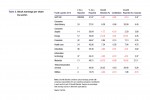Investing
Fixed Income
Just as a retrenchment in earnings can have a negative impact on hiring, slower growth or outright earnings declines are often reflected in fixed-income markets. The impact can be seen in quality spreads both between the yields of corporate bonds, or debt securities, and Treasurys, and among corporate bonds of different quality.
As the economy weakens and the yields on Treasurys decline, the odds of corporate bond defaults increase. Their yields increase (or decrease less) and the spread, or difference in yields, between government and corporate bonds increases.
Yet not all corporate bonds are equal. Companies that are perceived by credit- rating agencies to be less creditworthy or more at risk of default are given a lower grade. Those scoring below a certain level represent a higher risk to investors and are referred to as “junk” bonds. These typically must provide a higher yield to attract investors. Since these lower-rated companies are generally more at risk of default, the yields on their debt securities are often more sensitive to changes in the economic environment; moreover, their bonds typically see their yield spreads widen the most when economic conditions weaken.
Widening spreads can be seen clearly in the relative yields of highly rated, or investment-grade, bonds versus junk bonds. The deceleration in corporate earnings growth since mid-2014 corresponds to the widening spread of junk securities over investment-grade debt. Similar episodes occurred in 2000 – 2001 and 2007 – 2009 (Chart 5).
As with the labor market, improving economic activity along with better sales and earnings growth would likely lead to better performance among the bonds of the lowest-rated companies, the issuers of junk bonds. Stronger economic growth would likely lead to a narrowing of spreads between junk and investment-grade debt.
Commodities
One of the strongest ongoing themes, and one we have been writing about for many months, is the plunge in commodity prices. Last month we looked at its impact on capital spending. This month we look at its effect on earnings and jobs.
Prices for energy commodities and industrial metals hit a post-recession peak in 2011. Since that time, price measures for both have fallen 40 percent to 60 percent (Chart 6). At the same time, earnings for metal producers and mining companies have moved into the red, and employment in mining has fallen by 15 percent (Chart 7).
If and when commodity prices rebound, the impact on earnings, jobs, and other aspects of the overall U.S. economy should also reverse, but predicting that turnaround is an extremely difficult task.
Click here to receive email notifications when the latest Business Conditions Monthly is available.
U.S. Equities
Gross domestic product reflects the overall performance of the economy’s various components. So, too, does the Standard & Poor’s 500 Index of U.S. equities, where the aggregate data mask a wealth of information about the various components.
Our theme this month focuses on mixed signals from recent economic data and the potential value of a detailed analysis of corporate earnings data being released over the past few and next several weeks. Our work so far has shown that corporate sales and earnings are related to economic activity and the labor market. Further analysis corroborates some ongoing themes while also highlighting key areas to monitor:
Energy and materials, the commodity-sensitive sectors, have seen a complete collapse in earnings—fallout from the plunge in commodity prices. Energy- sector earnings are expected to be down about 74 percent for the fourth quarter compared with a year ago and are by far the biggest factor in the expected 5.7 percent decline in S&P 500 earnings overall. Materials-sector earnings are expected to be down about 25 percent.
Consumer discretionary, health care, and telecommunications services—mostly domestically focused sectors—are expected to show positive growth in earnings from a year ago and are the largest contributors to S&P 500 earnings. Consumer discretionary and health care are also sectors that have had strong job growth, so continued earnings gains are important for the hiring outlook.
Industrials and information technology—more global sectors—are expected to show declines in earnings for the fourth quarter. Recoveries in these sectors are likely to be delayed until global growth picks up.
Global Equities
This report has looked at the well established and widely recognized short- and immediate-term relationships between the U.S. economy and capital markets. They are indeed tightly integrated.
However, the tight integration is less evident in China, where at least some measures of equity market performance seem disconnected from the condition of the underlying economy. From 2002 through 2005, the Shanghai composite stock index fell significantly despite accelerating growth in China’s GDP. From 2006 – 2007, the Shanghai index surged ahead in parallel with accelerating economic growth (at least through the early part of 2007). Both China’s GDP growth and equity markets tumbled in 2008 and posted a rebound in 2009.
From 2010 through the middle of 2014, both GDP and the equity markets steadily decelerated in the Asian nation. However, in mid-2014 the Shanghai index began a surge and more than doubled, while GDP continued to slow. Clearly the index surge was unsustainable—it is already deflating—and likewise, further collapse in the equity market is possible as cooling GDP growth shows no sign of reviving.
Compounding the variance between the equity market and the real economy is that both are heavily influenced by the Chinese government. Our conclusions are two-fold: First, the equity market declines in China may not be over. Second, since the government tends to interfere in both the market and the real economy, investors in China equities take on an unusually high degree of uncertainty.





